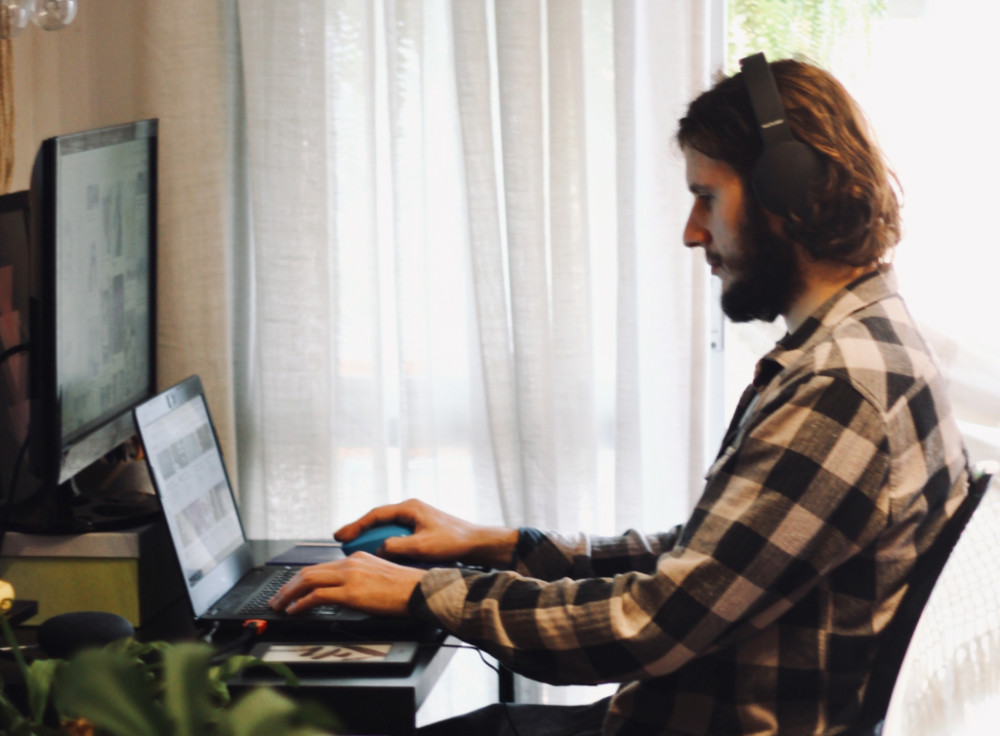
In an article first published on The Conversation, BRITTANY HARKER MARTIN, of Canada’s University of Calgary, gives some tips for how to adjust to working in what can be a crowded house…
With much of the globe self-isolating, many people must suddenly manage the complexities of working from home while sharing a crowded space.
Kitchens, dining rooms and other spaces have become offices for remote work with computers, cords and paperwork spilling into what was, until very recently, private space. For people with children, these spaces are also the daycare and an impromptu home-school with everyone trying to remain productive in the middle of the chaos of competing demands.

A busy workspace: Dad works while toddler does online-preschool, twins adjust to home-kindergarten and mom, on a break, takes the photo. PICTURE: Lesli Harker.
The term “remote work” means different things to different people. Many think of it as working away from a central office or school by connecting through communication technologies, such as email, intranets and video conferencing. Academia has yet to establish a common definition for this type of work that is accepted by all. In this article, I’m using the term as it is currently being used by the public in reference to working from home.
As a teacher with a doctoral degree in business that focused on remote work, I have a unique vantage point for this emerging situation of working from home in a house full of people, of all ages. In order to be effective and minimise stress, I recommend taking time to create a structure that everyone agrees to.
Here are five ways to organise the home-work environment for a more successful transition.
Create workstations
Assigning a workstation to each person gives everyone a sense that they belong in the newly shared space, while setting boundaries for personal space.
The workstations should make sense for the work being done. If the work is loud and disruptive, like video conferences or multimedia streams, assign that work to a room with a door. For quiet work that requires concentration, ear plugs or headphones with white noise may be needed.
Taking a few moments to set up space for success will save the whole household from feeling frazzled.
Designate a work-free zone
If you have a home with a separate room for relaxing, such as a family room or den, consider making it a work-free zone.
In smaller places, this can be the bedrooms or even designated areas, such as a table with games and puzzles, or a corner with books and drawing materials. This can be especially helpful when there are children on the scene.
Designating a space that is not for work is part of creating healthy work-life boundaries for psychological wellness.
Take scheduled breaks
The most common misconception about remote work is that it enables slackers. In fact, slacking is often more about personality and fit than the work context.
Successful remote workers are driven by the outcomes they are trying to deliver, and research shows they are not always exemplars of work-life balance.
Taking scheduled breaks not only keeps your mind fresh, but it also signals to others that wellness is important. If you are in self-isolation with children, your behaviour is teaching them what work-life looks like, so be sure to infuse a priority for wellness by modelling it yourself.
Integrate physical and creative activities
As adults, we know that it is important to make time for exercising and engaging our minds. Children have such activities scheduled into their school day, through recess, gym and creative subjects like art and music.
If you are self-isolating, it is essential to schedule physical and creative activity into each day – for everyone. If the weather allows, get outside, or plan to do indoor physical activities like yoga, dance games and interactive video games. Make it timed. Make it fun. The important thing is to schedule it.
It is also important to schedule time for creative activities. Consider how you can add the arts to the schedule, and remember: if it makes noise or a mess don’t schedule it for children when you don’t have the capacity to manage it, or it might not be the positive experience you are trying to create.
Establish a firm quitting time
A set quitting time helps us feel we have psychological control over our work. It also establishes boundaries and a sense of routine.
Children who are accustomed to timed periods, bells for breaks and a set time to go home still require structure and routine to make them feel safe, especially during these uncertain times. For children and adults, setting a timer and establishing the norm that work-time has a beginning and an end can signal familiar norms of the workplace and school, and lead to more effective behaviours for sharing space together.
These five tips are research-informed, yet as a parent who has worked remotely for years, I have also used them. The most important thing, in addition to implementing each tip, is to have an open dialogue with family, roommates or whomever shares your space and to be flexible enough to adapt to the different, emerging needs as they arise.
Everyone feels the stress of uncertainty; everyone wants life to feel as normal as possible.![]()
Brittany Harker Martin is an associate professor in leadership, policy and governance at the University of Calgary. This article is republished from The Conversation under a Creative Commons license. Read the original article.





